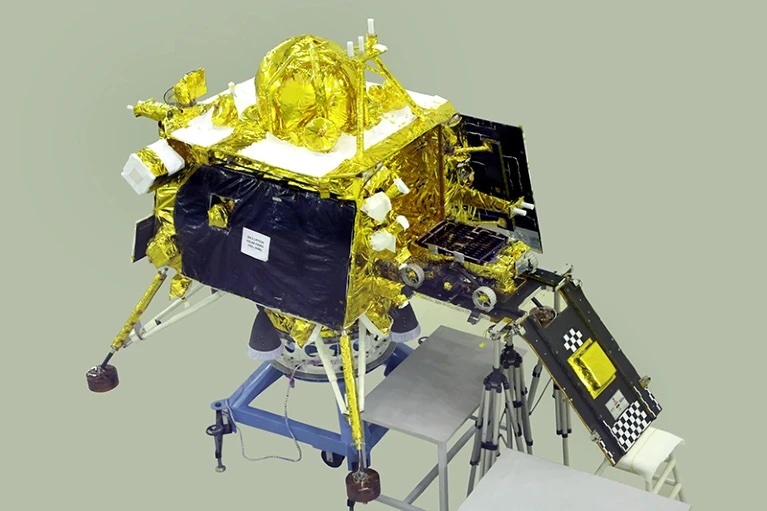16.06.2023
ISRO Unveils Pictures Of Chandrayaan-3 Lander Ahead Of July Launch
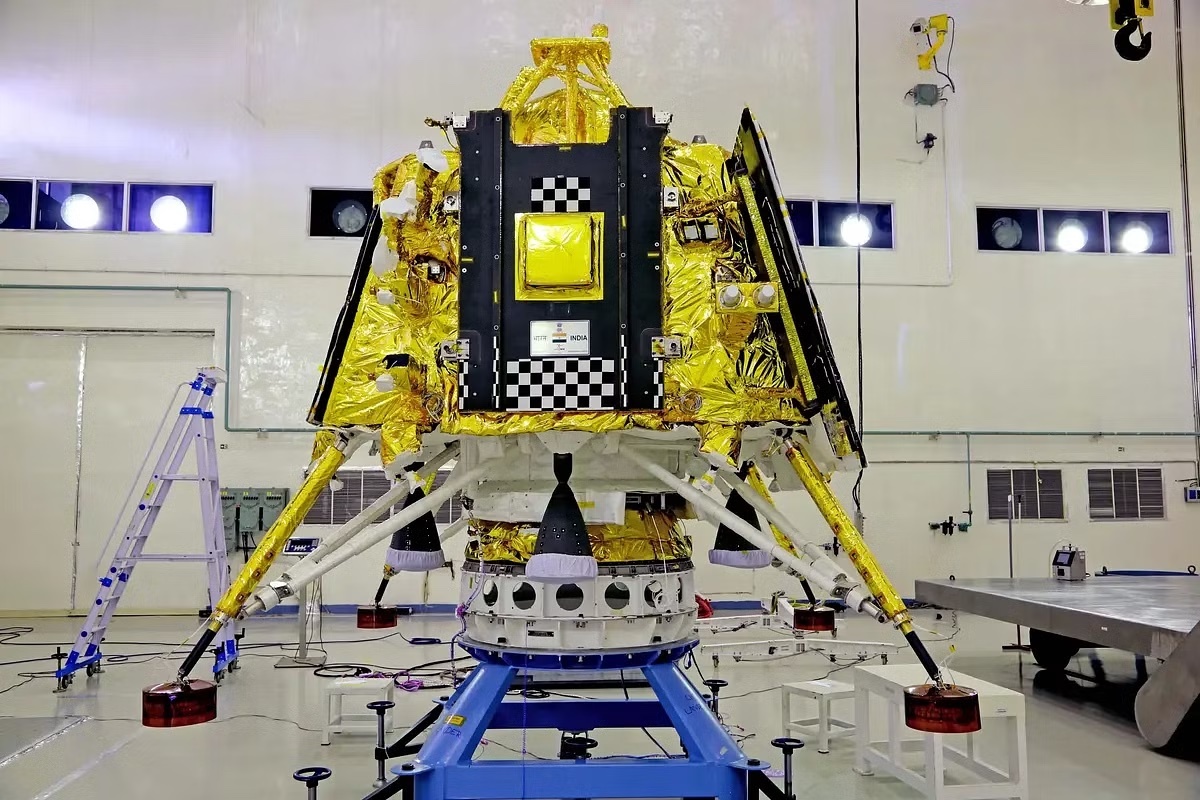
The Indian Space Research Organisation (ISRO) has recently released images of the Chandrayaan-3 lander, providing a glimpse into the eagerly anticipated lunar mission scheduled for launch in July.
ISRO Chairman S Somanath announced earlier this week that if all tests progress as planned, Chandrayaan-3, the third iteration of India's lunar mission, will take off between 12 and 19 July.
Quelle: Swarajya
+++
ISRO Releases New Pictures Of Chandrayaan-3 Ahead Of Its Anticipated Launch In July
Indian Space Research Organisation (ISRO) has released a series of new images showcasing the upcoming Chandrayaan-3, India's mission to the Moon.
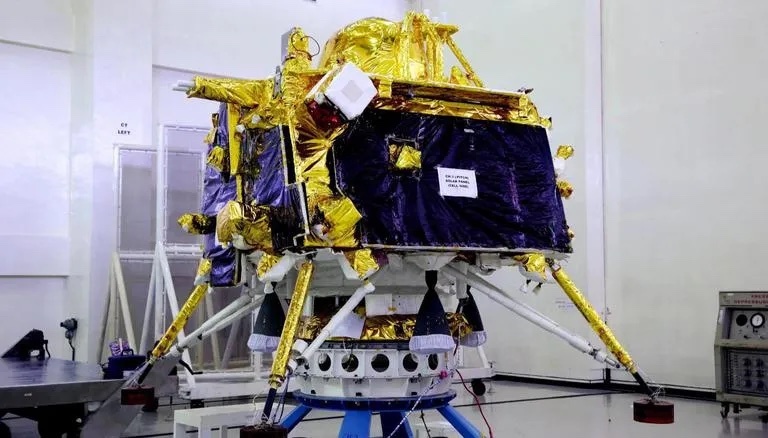
Chandrayaan-3 in anticipated to be launched in July. (Image: ISRO)
The Indian Space Research Organisation (ISRO) has unveiled a series of new images showcasing the upcoming Chandrayaan-3 mission, India's ambitious plan to land on the surface of the Moon. These fresh images of Chandrayaan-3 come days after ISRO Chairman, in a recent statement, shared insights into the anticipated launch timeline of Chandrayaan-3. It is speculated that the mission could embark on its extraordinary journey sometime between July 12-19, further intensifying the excitement surrounding the upcoming lunar exploration.
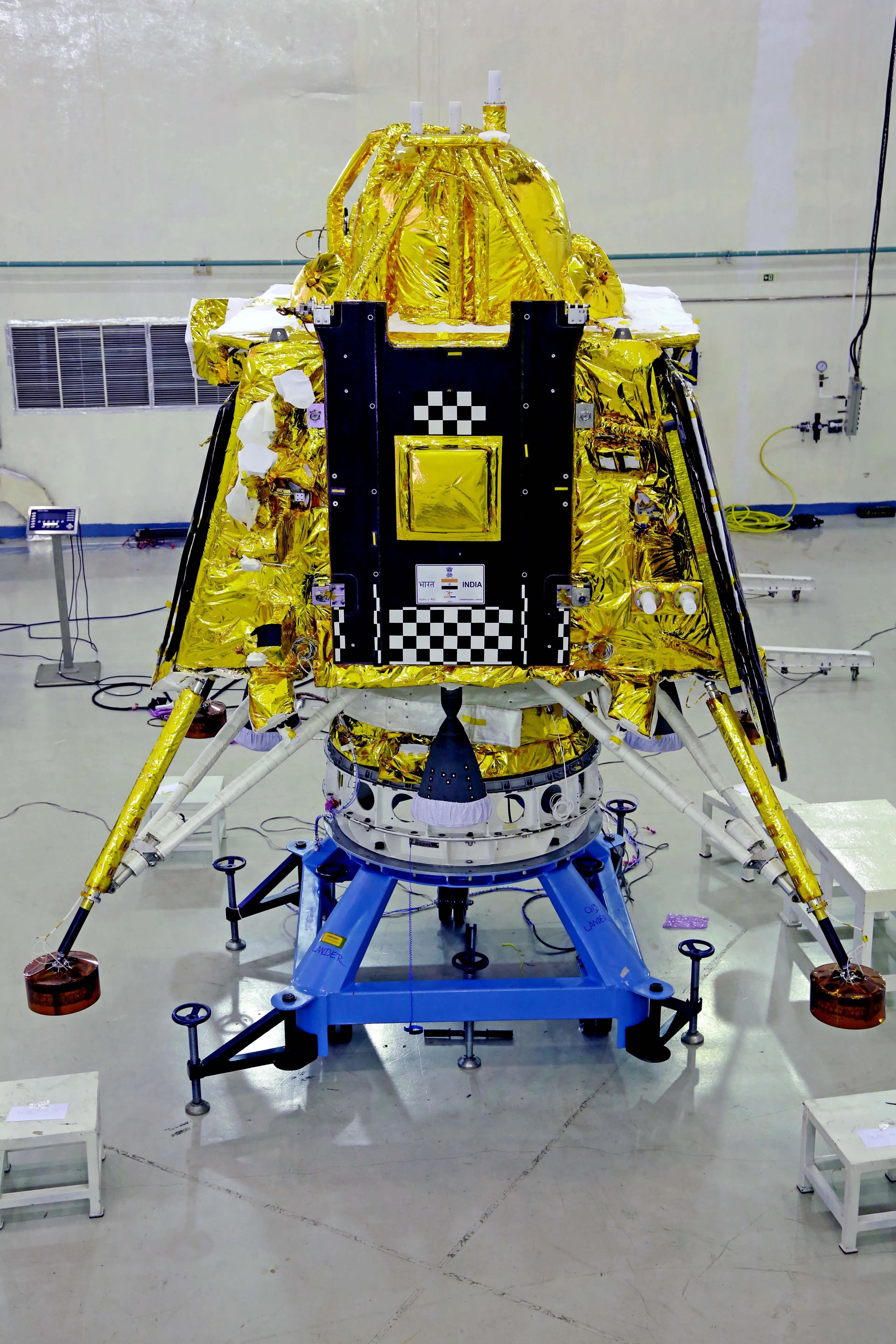
With the release of these new images, ISRO has provided space enthusiasts and the scientific community a glimpse into the advancements and preparations for the upcoming Chandrayaan-3 mission. The mission holds significant promise for India's space exploration endeavours and is set to further enhance the nation's expertise in lunar exploration and technology.
Chandrayaan-3: India's mission to Moon
Chandrayaan-3 is a continuation of the Chandrayaan-2 mission, with the primary objective of demonstrating the complete process of safe landing and roving on the lunar surface. The mission configuration includes a Lander module, a Propulsion module, and a Rover, each designed to develop and showcase new technologies essential for future interplanetary missions.
The Lander module is designed to achieve a soft landing on a predetermined lunar site, where it will deploy the Rover. The Rover, equipped with scientific instruments, will conduct in-situ chemical analysis of the lunar surface while exploring its surroundings.
The Propulsion module plays a crucial role in carrying the Lander module from the injection point provided by the launch vehicle until it reaches a final lunar orbit of approximately 100 km in altitude, according to ISRO. Additionally, the Propulsion module also features a scientific payload that will be operational after the separation of the Lander module.
As per the ISRO, the chosen launcher for the Chandrayaan-3 mission is the Geosynchronous Satellite Launch Vehicle-Mark 3 (GSLV-Mk3), which will place the integrated module into an elliptical parking orbit of approximately 170 x 36,500 km.
The key objectives of the Chandrayaan-3 mission are threefold. Firstly, it aims to demonstrate the capability of achieving a safe and soft landing on the lunar surface, a crucial step for future lunar missions. Secondly, it seeks to demonstrate the mobility and functionality of the Rover on the lunar terrain. Finally, Chandrayaan-3 will conduct in-situ scientific experiments, gathering valuable data and insights about the lunar environment.
Quelle: REPUBLICWORLD.COM
----
Update: 27.06.2023
.
Chandrayaan-3 | Lander Vikram, rover Pragyan to return for another tryst with the moon
Chandrayaan-3 lander, rover named after those in the previous mission; India’s third moon exploration mission slated for mid-July launch
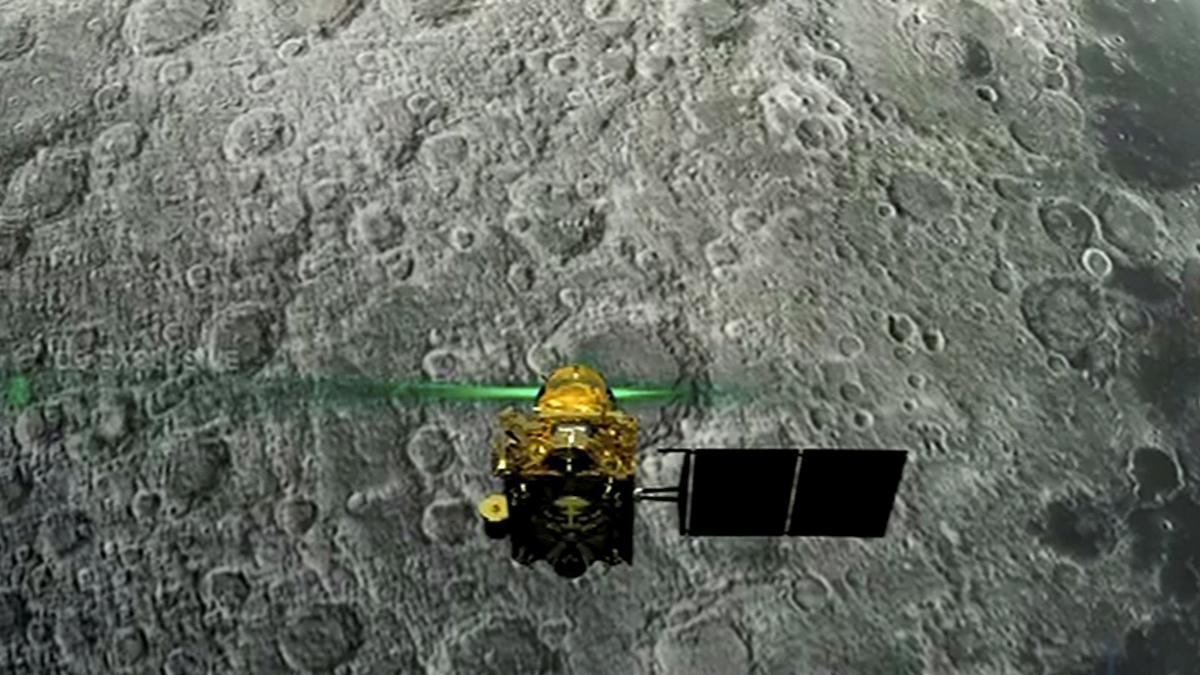
This screen grab taken from a live webcast by ISRO on August 6, 2019 shows Vikram Lander before it is supposed to land on the Moon. | Photo Credit: PTI
Names are something that India’s third moon exploration mission, slated for a mid-July launch as things stand, will share with the 2019 Chandrayaan-2 lunar adventure. Apart from the obvious ‘Chandrayaan,’ that is.
The Indian Space Research Organisation (ISRO) plans to retain the names of the Chandrayaan-2 lander and rover for their Chandrayaan-3 equivalents as well, Chairman of the space agency S. Somanath told The Hindu. This means, the Chandrayaan-3 lander will bear the name ‘Vikram’ (after Vikram Sarabhai, the father of the Indian space programme) and the rover, ‘Pragyan’.
Much to its disappointment, the ISRO had lost the Chandrayaan-2 lander-rover configuration and the payloads aboard them after ‘Vikram’ crashed on the lunar surfacewhile attempting a soft landing.
Earlier this month, Mr. Somanath had announced ISRO’s plans to launch the third moon mission in mid-July aboard the LVM3 (formerly GSLV Mk-III) rocket from Sriharikota.
A propulsion module will carry the lander-rover configuration to a 100-km lunar orbit. Once the ‘Vikram’ lander module makes it safely to the moon, it will deploy ‘Pragyan’ ‘‘which will carry out in-situ chemical analysis of the lunar surface during the course of its mobility,’‘ according to the ISRO.
Scientific experiments
The lander, rover and the propulsion module will have payloads for performing experiments designed to give scientists new insights into the characteristics of earth’s lone natural satellite.
The lander will have four payloads — Radio Anatomy of Moon Bound Hypersensitive ionosphere and Atmosphere (RAMBHA), Chandra’s Surface Thermo physical Experiment (ChaSTE), Instrument for Lunar Seismic Activity (ILSA) and the LASER Retroreflector Array (LRA). The six-wheeled rover will have two payloads — the Alpha Particle X-ray Spectrometer (APXS) and the LASER Induced Breakdown Spectroscope (LIBS).
In addition to these, there will be one payload on the propulsion module, the Spectro-polarimetry of HAbitable Planet Earth (SHAPE).
- The Indian Space Research Organisation (ISRO) plans to retain the names of the Chandrayaan-2 lander and rover for their Chandrayaan-3 equivalents as well.
- This means, the Chandrayaan-3 lander will bear the name ‘Vikram’ (after Vikram Sarabhai, the father of the Indian space programme) and the rover, ‘Pragyan’.
- Much to its disappointment, the ISRO had lost the Chandrayaan-2 lander-rover configuration and the payloads aboard them after ‘Vikram’ crashed on the lunar surface while attempting a soft landing.
Quelle: The Hindu
----
Update: 5.07.2023
.
Startvorbereitung von ISROs Chandrayaan-3, Aditya L-1 Solar Mission
Today, at Satish Dhawan Space Centre, Sriharikota, the encapsulated assembly containing Chandrayaan-3 is mated with LVM3.
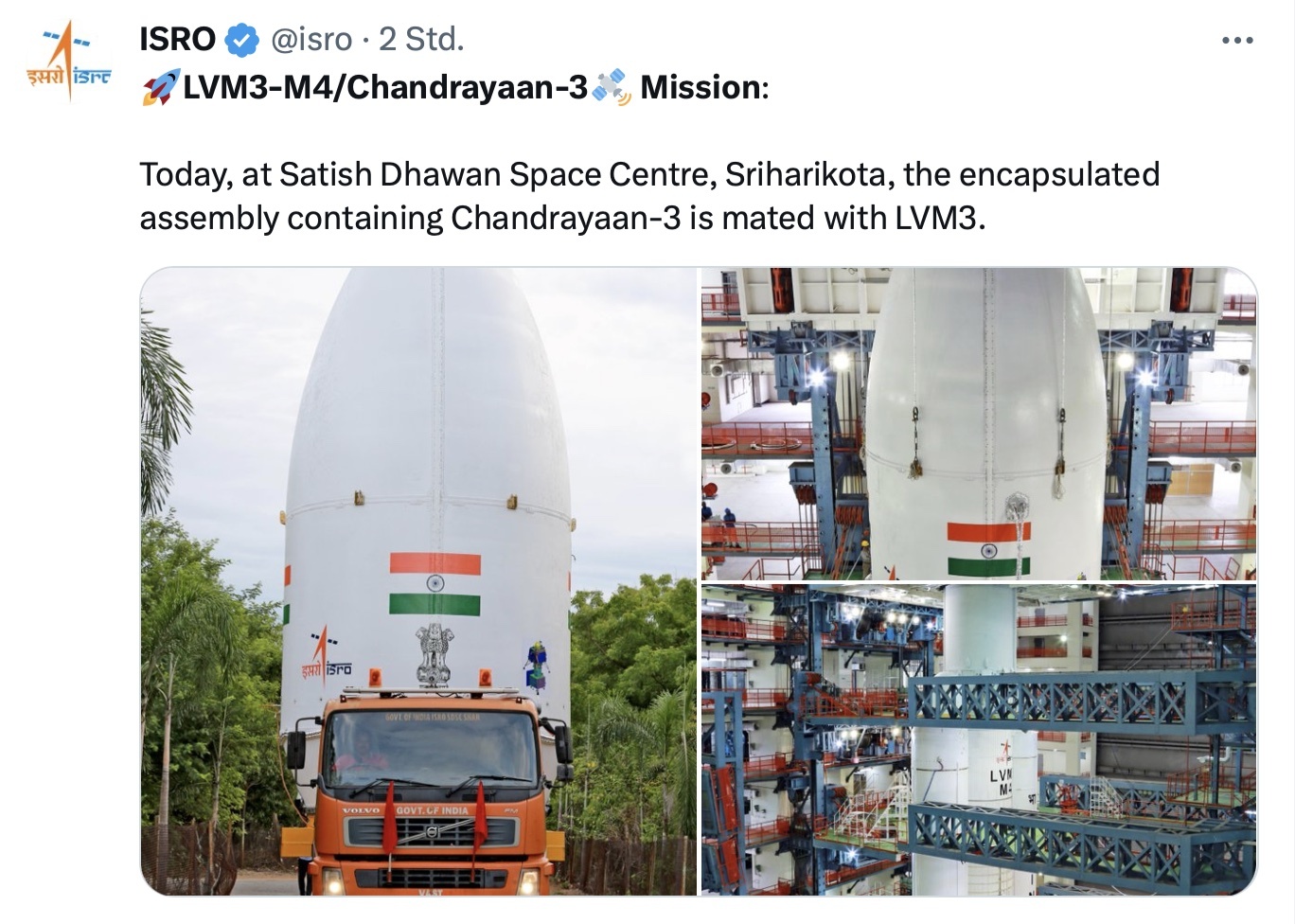
Quelle: ISRO
----
Update: 8.07.2023
.
India shoots for the Moon with Chandrayaan-3 lunar lander

